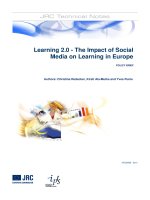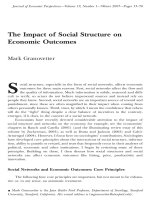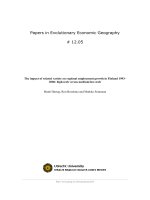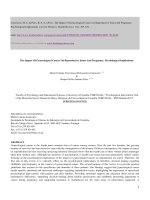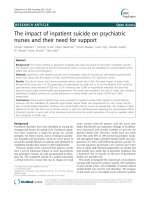Fighting your feelings the impact of emotion regulation on consumer judgment and choice
Bạn đang xem bản rút gọn của tài liệu. Xem và tải ngay bản đầy đủ của tài liệu tại đây (620.33 KB, 111 trang )
FIGHTING YOUR FEELINGS:
THE IMPACT OF EMOTION REGULATION ON
CONSUMER JUDGMENT AND CHOICE
QIU CHENG
(M. Econ. Fudan University, China)
A THESIS SUBMITTED
FOR THE DEGREE OF DOCTOR OF PHILOSOPHY
DEPARTMENT OF MARKETING
BUSINESS SCHOOL
NATIONAL UNIVERSITY OF SINGAPORE
2007
i
ACKNOWLEDGEMENTS
First and foremost, I would like to express my sincere gratitude to my
supervisors, Associate Professor Lee Yih Hwai and Assistant Professor Catherine
Yeung, for their professional guidance and support throughout my doctoral study at
the National University of Singapore. I very much appreciate the contribution of my
dissertation committee member Professor Leong Siew Meng.
I would like to express my special thanks to Associate Professor Ang Swee
Hoon, Assistant Professor Li Xiuping, and Assistant Professor Tambyah Siok Kuan
for their insightful comments. I am indebted to the participants in the seminars at the
NUS for their valuable comments and suggestions. I also want to thank my fellow
Ph.D. students for their support and companionship.
Last but not least, I wish to express my deepest appreciation to my family for
always being supportive of my efforts in pursuing the Ph.D.
ii
TABLE OF CONTENTS
Pages
Acknowledgements ………………………………………………………………….i
List of Tables………………………………………………………………….……….v
List of Figures………………………………………………………………….…… vi
Summary… …………………………………………………………………….… vii
Chapter 1 Introduction………………………………………………………… 1
1.1 Research Motivation………………………….…………….…… 3
1.2 Research Framework……………………… …………….………5
Chapter 2 Emotion Regulation and Consumer Judgment………………………….8
2.1 Emotion Regulatory Strategies……………… ………………… 9
2.1.1 Emotion Categorization and Emotion Generation… 10
2.1.2 Reappraisal…………………… …………………….13
2.1.3 Suppression………………….….….………………15
2.1.4 Resource Requirement of Reappraisal and
Suppression 17
2.2 The Impact of Emotion Suppression on Consumer Judgment…19
2.2.1 Emotion Suppression, Resource Consumption, and
Central Executive Functioning…………………… 19
2.2.2 Central Executive Functioning, Product Information
Processing, and Consumer Judgment …….………….21
Chapter 3 Experiments: Part I…………….…………………………………… 24
3.1 Experiment 1 …………….……………… ………………….24
3.1.1 Overview………………………………………… 24
3.1.2 Stimuli Development…………………… ………… 25
3.1.3 Manipulations………………….….….………………27
3.1.3.1 Manipulation of Regulatory Strategy… ……27
3.1.3.2 Manipulation of Cognitive Resource… ……29
3.1.4 Procedure and Measures 29
3.1.5 Results…… ………………….….….………………31
3.1.5.1 Manipulation and Confounding Checks ……31
3.1.5.2 Emotional Reaction.……………… … ……32
3.1.6 Discussion ………………….….….………………36
3.2 Experiment 2 …………….……………… ………………….37
3.2.1 Overview………………………………………… 37
iii
3.2.2 Stimuli Development…………………… ………… 38
3.2.3 Procedure and Measures 42
3.2.4 Results…… ………………….….….………………43
3.2.4.1 Manipulation Check.………………… ……43
3.2.4.2 Judgment of Image Quality Capability ……43
3.2.4.3 Product Liking……………………… ……45
3.2.5 Discussion ………………….….….………………46
3.3 Experiment 3 …………….……………… ………………….48
3.3.1 Overview………………………………………… 48
3.3.2 Marketplace Metacognition …………… ………… 48
3.3.3 Method………………………… 50
3.3.4 Results…… ………………….….….………………51
3.3.4.1 Manipulation Check.………………… ……51
3.3.4.2 Judgment of Image Quality Capability ……51
3.3.4.3 Product Attitude…………… ……………… 54
3.3.5 Discussion ………………….….….………………54
Chapter 4 Emotion Regulation and Consumer Choice………………………… 56
4.1 Comparing Resources Required and Resources Available…….…56
4.2 The Impact of Emotion Suppression on Consumer Choice……58
Chapter 5 Experiments: Part II…………….…………………………………… 60
5.1 Experiment 4 …………….……………… ………………….60
5.1.1 Overview………………………………………… 60
5.1.2 Stimuli Development…………………… ………… 61
5.1.3 Procedure and Measures 64
5.1.4 Results…… ………………….….….………………66
5.1.4.1 Manipulation Check………………… ……66
5.1.4.2 Product Choice…………………… … ……66
5.1.4.3 Relative Preference… …………… … ……67
5.1.5 Discussion ………………….….….………………69
5.2 Experiment 5 …………….……………… ………………….71
5.2.1 Overview………………………………………… 71
5.2.2 Stimuli Development…………………… ………… 72
5.2.3 Results…… ………………….….….………………75
5.2.3.1 Manipulation Check.………………… ……75
5.2.3.2 Product Choice…………………… … ……76
5.2.3.3 Relative Preference… ……………… … …76
5.2.4 Discussion ………………………….….….………79
iv
Chapter 6 General Discussion…………………………………………………… 81
6.1 Summary…………………….……………… ………………….81
6.2 Additional Considerations………………………………………83
6.2.1 Emotion Suppression versus Mood/Thought
Suppression……… …….………… 83
6.2.2 Emotion Regulation and “Rationality”.… ………… 84
6.3 Contributions…………………………………………………… 85
6.3.1 The Nonuse of Feelings and Consumer Judgment …85
6.3.2 Emotion Regulation and Information Processing……86
6.3.3 The Differing Resource Requirement of Different
Regulatory Strategies …….………….87
6.3.4 Implications for Marketing Practitioner and
Consumer Well-Being …….……….….88
6.4 Limitations.…………………………………………………… 89
6.5 Future Research Directions…………………………………… 90
6.6 Concluding Remarks…………………………………………… 92
Bibliography………………………………………………………… ……………94
v
LIST OF TABLES
TABLES PAGES
3.1 Argument Strength with Reference to the Camera’s Ability to Produce
High-Quality Images……………… … ………………………………… 41
vi
LIST OF FIGURES
FIGURES PAGES
3.1 High-Aesthetic and Low-Aesthetic Product Design—Experiment 1……… 26
3.2 Emotional Reaction toward Product Design—Experiment 1… …… 35
3.3 Emotional Component of the Advertisement—Experiments 2 and 3…… 39
3.4 Results of Experiment 2…………………………………………….……… 44
3.5 Results of Experiment 3…………………………………………….……… 53
4.1 Resources Required versus Resources Available………………… ……… 57
5.1 Pictures of Stimuli Employed in Experiment 4………………… ………….62
5.2 Results of Experiment 4…………………………………………….……… 68
5.3 Pictures of Stimuli Employed in Experiment 5………………… ………….72
5.4 Manipulation of Processing Difficulty—Experiment 5…………………… 74
5.5 Results of Experiment 5…………………………………………….……… 78
vii
SUMMARY
Consumers may regulate their emotional reactions toward marketing stimuli in
order to depend less on their emotions to make product judgments and choices.
However, this research suggests that under certain circumstances, regulating emotion
may paradoxically increase the reliance on it.
Building on the consensual model of emotion regulation, this research
examines two important emotion regulatory strategies that consumers may apply at
different stages of the emotion generative process, namely, the reappraisal strategy
and the suppression strategy. The reappraisal strategy refers to the interpretation of a
stimulus from a neutral and detached perspective so as to decrease the emotional
relevance of the stimulus, whereas the suppression strategy refers to the inhibition of
ongoing emotional response tendencies toward a stimulus during the emotion
generative process. Experiment 1 compares the resource requirement of these two
strategies and establishes the premise that emotion suppression consumes appreciable
cognitive resources whereas reappraisal does not. The subsequent experiments show
that, as a result of its requisite cognitive inputs, suppressing emotional reactions may
impair consumers’ ability to process product information systematically (experiments
2 and 3) as well as induce consumers to make emotion-based choices (experiments 4
and 5). These findings contrast the popular notion that managing emotions should
result in rational judgments that are based on objective product information. Moreover,
demonstrating that the nonuse of feelings could have an impact on consumer judgment,
this research complements previous research on how the use of feelings influences
consumer judgment to provide a more complete theoretical account of the impact of
feelings on consumer judgment.
- 1 -
CHAPTER 1
INTRODUCTION
People may believe that they can be more objective by managing their
emotions. Such belief dates back to ancient Greece when Plato posed emotion against
reason in his philosophical discussion (Plato/Bloom 1991). It is also reflected in the
psychoanalysis of the conflict between the pleasure principle (satisfying immediate,
hedonic motives) and the reality principle (achieving long-term benefits; Freud 1911).
Consumers nowadays may again attempt to control their emotional reactions toward
enticing products to reduce impulsive purchase decisions (Hoch and Loewenstein
1991; Kacen and Lee 2002; Rook 1987).
The marketplace is abundant with products appealing to consumers’ emotions,
ranging from tempting desserts, cute lifestyle products, stylish electronic appliances,
to fashionable clothes. However, consumers may not always want to rely on their
emotions when evaluating and choosing products (e.g., Adaval 2001; Shiv and
Fedorikhin 1999). Yet one problem inherent in the nonuse of emotions is that
emotions are associated with motivational impact and action tendency (Bargh 1999;
Ben-Ze’ev, 2000; Frijda 1986). Consumers who feel good about a product may have
an inclination to approach the product. Because of this, it is unlikely that they can
discard their emotions as a piece of unimportant product information effortlessly.
- 2 -
Rather, they may adopt various strategies to regulate their emotional reactions toward
products to avoid emotion-driven purchase decisions (Hoch and Loewenstein 1991;
Kacen and Lee 2002). For example, consumers who are on diet may suppress their
desire for a piece of delicious cheese cake; similarly, consumers who are considering
a digital camera may try to evaluate it based on its functional features and down-play
their positive feelings toward its sleek design. Failure to regulate emotional reactions
toward products may lead to impulsive buying decisions which consumers regret later
on (Rook 1987; Weinberg and Gottwald 1982).
When consumers regulate their emotions, they may believe that they would be
able to focus on the non-emotional product information such as the product’s
utilitarian functions, and hence adopt a less emotion-laden processing frame. The
current research, however, suggests that the consequences of regulating emotional
reactions toward marketing stimuli are not as straightforward, as there may be costs
associated with emotion regulation. Under certain circumstances, emotion regulation
may impair product judgment and, consequently, lead to an ironically emotion-based
choice. So, one important objective of this research is to provide contrary evidence
that consumers can always be more objective in their judgments and choices by
managing their emotions. The research also specifically details the explanations for
why the regulation of emotions may have an impact on consumer judgment and
identifies conditions under which this is likely to happen. These attempts represent an
effort to bridge a gap in the literature on the impact of feelings on consumer judgment.
In the following sections, the gap in the literature on feelings and consumer
judgment is identified and the motivation for this research is presented. Next an
overview of the research framework is provided.
- 3 -
1.1 RESEARCH MOTIVATION
An accumulating body of research has demonstrated that feelings
1
have a
pervasive impact on judgment. Feelings may serve as judgment heuristics (Slovic et al.
2002), as well as valuable information cues (Schwarz and Clore 1983, 1996; Pham
1998, 2004). Moreover, previous research has identified the conditions under which
feelings would be incorporated into product judgments. First, consumers need to
perceive the product being evaluated as the actual source of their feelings (Strack
1992). If their feelings are attributed to sources other than the product being evaluated,
they would cease to influence judgments (Gorn, Goldberg, and Basu 1993; Schwarz
and Clore 1983). Second, consumers need to regard their feelings as a relevant basis
for evaluating the product. In this regard, feelings would serve as informational input
for product judgments under situations where consumers use hedonic criteria (i.e.,
how it feels to use the product) to evaluate the product, but not under situations where
consumers use utilitarian criteria (i.e., how good the product function is) to evaluate
the product (Pham 1998).
Note that although in most of the previous studies,
1
Research on feelings and judgment has sometimes used the terms affect, emotion, and feeling
interchangeably. Following previous research (Forgas 1995; Gross 1998; Larsen and Prizmic 2001;
Pham et al. 2001; Scherer 1984; Schwarz and Clore 1996), the current research defines these
terms as follows. Affect is a generic term used for all kinds of valenced states, including emotion,
mood, emotional episodes, as well as affective dispositions. Both emotion and mood fall under the
overarching category of affect, but compared to mood, emotion has a more specific referent and
higher intensity. Feeling, as used in most consumer behavior research (e.g., Pham 1998; Pham et
al. 2001), refers to affective response that encompasses extraneous mood and emotional reaction;
nevertheless, feeling may include physiological response or metacognitive experience such as
feeling of familiarity as well (Schwarz and Clore 1996). The current research mainly uses the term
emotion because the research focus is on the regulation of stimulus-based affective response
toward marketing stimuli which, unlike mood, has a specific referent. Note such emotional
reactions toward marketing stimuli may be subtler than a specific type of emotion (e.g., joy, anger).
- 4 -
participants’ feelings were induced extrinsically by mood induction procedures (as
opposed to feelings generated intrinsically from products and advertisements), the
findings have implications for the use of feelings in judgments in general, regardless
of how these feelings are elicited.
Thus, previous research seems to imply that feelings would have an impact on
product judgment only when consumers intend to rely on their feelings. For such
instances, consumers who feel positively about a product may judge the product more
favorably than those who feel negatively about it. On the other hand, when consumers
do not intend to rely on their feelings, they can make product judgments based on the
objective product information as if their feelings toward the product do no exist at all.
In other words, the nonuse of feelings is assumed to be effortless. However, the
validity of this assumption has remained relatively unexplored. To this end, little
consumer behavior research has tapped into the process underlying the nonuse of
feelings, let alone investigating the consequent impact on consumer judgment.
Such investigation is of theoretical interest because of the emotion regulation
process that is involved and the consequent effect on product judgment and choice (as
compared with other forms of self-regulation behaviors). When both feelings for and
functional evaluations of a product become likely inputs to product judgment and
choice, consumers’ attempts to regulate their feelings (so that they can rely less on it)
can affect product judgment and choice in two ways: first, through the reduction of
feelings toward the product, and second, through the changes in the product function
judgment. These underlying processes differentiate emotion regulation from other
self-regulatory behavior (e.g., thought suppression) with regard to the effect on
consumer judgment and choice.
- 5 -
1.2 RESEARCH FRAMEWORK
Building upon recent psychology research in emotion regulation (Gross 1998;
Ochsner et al. 2002; Phelps 2006; Richards and Gross 2000; Schmeichel, Vohs, and
Baumeister 2003), the current research delineates a framework explaining the
processes and consequences of regulating emotional reactions toward marketing
stimuli.
When consumers encounter products or advertisements, they may naturally
have emotional reactions based on a quick appraisal of the physical appearance of the
products or the emotional advertising appeals. In the event that they do not want to
make emotion-based judgments, they may adopt a variety of emotion regulatory
strategies to reduce their emotional reactions. As this research focuses on emotion
regulation during the product evaluation process, the cognitive regulation of emotions
is particularly applicable (cf., behavioral regulatory strategies such as avoiding
evaluating the product). More specifically, two important strategies that are frequently
adopted in everyday life (Gross, Richards, and John 2006) — the reappraisal strategy
and the suppression strategy—are examined in this research.
The reappraisal strategy refers to the interpretation of a stimulus from an
emotionally detached perspective, which can be applied before emotions are actually
elicited (e.g., before attention is given to the emotion-eliciting stimulus) to reduce the
generation of emotional reactions (Gross 1998; Larsen and Prizmic 2004). The
suppression strategy refers to the inhibition of ongoing emotional response tendencies
(e.g., while attending to the emotion-eliciting stimulus), which can be applied during
- 6 -
the emotion generative process (Gross 1998; Schmeichel, Vohs, and Baumeister 2003).
These two strategies are chosen for investigation based on two theoretical
considerations. First, they represent regulatory strategies that can be applied at
different stages of the emotion generative process—prior to emotion generation
versus during emotion generation. Second, because of the process differences, they
may require different levels of cognitive-resource input. Reappraisal alters the entire
emotion generative process from the very beginning and hence requires minimal
cognitive resources to monitor and adjust emotional reactions subsequently. In
contrast, suppression is applied when consumers detect emotional response tendencies,
the implementation of which requires consumers to engage in a loop of monitoring
and inhibiting their emotions continually during the product evaluation process. Thus,
suppression should consume greater cognitive resources than reappraisal (Gross 1998;
Richards and Gross 2000) and may potentially entail consequences for consumer
judgment.
To understand the basis of how emotion regulation affects consumer judgment
and choice, experiment 1 compares the cognitive-resource requirement for
reappraising and suppressing feelings toward products. Findings from this experiment
establish the premise that effective emotion suppression consumes appreciable
cognitive resources whereas reappraisal does not.
Because consumers have finite cognitive resources at any given time (Lynch
and Srull 1982; Payne 1982), fewer resources would be left for processing product
attribute information when emotion suppression consumes part of the resources.
Based on this logic, subsequent experiments focus on the suppression strategy and
examine the implications of its cognitive-resource requirement to consumer judgment
- 7 -
and choice. Specifically, experiments 2 and 3 show that contrary to the popular notion
that managing emotions should result in accurate judgments that are based on
objective product features, successful suppression of emotional reactions toward
marketing stimuli may impair consumers’ capability to process product attribute
information systematically. Experiments 4 and 5 further suggest that under conditions
where product function information is difficult to process, consumers who suppress
their feelings toward products, compared to those who do not, may be more inclined
to make emotion-based choices (i.e., choose the alternative that is superior in affective
dimension). Demonstrating these potential effects of the nonuse of feelings on product
judgment and choice, the present research complements the previous research on the
use of feelings in consumer judgment to provide a more complete theoretical account
of the impact of feelings on consumer judgment.
In the following chapters, previous research on emotion generation, emotion
regulation, and product judgment is reviewed, upon which the conceptual framework
of this research is developed. Next, three experiments examining the impact of
emotion regulation on product judgment are presented. Thereafter, further hypotheses
regarding emotion regulation and consumer choice are developed, followed by a
report of two experiments examining the impact of emotion regulation on choice.
Finally, implications of the present research and avenues for future research are
discussed.
- 8 -
CHAPTER 2
EMOTION REGULATION AND
CONSUMER JUDGMENT
Firms frequently incorporate emotional features in the design of products and
advertisements to enhance consumers’ liking for their products. For example, the
design aesthetics of a product can be a strategic advantage to firms in the competitive
marketplace (Kotler and Rath 1984). Prior research has demonstrated design
aesthetics’ ability to evoke favorable emotional reactions (Bloch 1995; Bloch, Brunel,
and Arnold 2003; Csikszentimihalyi and Robinson 1990), which may lead to brand
preference (Veryzer 1993), buying impulse (Rook 1987), and final acquisition of the
product (Bloch 1995). Another common emotion-evoking marketing stimulus is in
emotional advertising appeal, which may influence product judgments by eliciting
emotions among consumers. For example, positive emotional reactions toward an
advertisement may be translated into liking for the advertisement, liking for the
product being advertised, and purchase intention (Aaker, Stayman, and Hagerty 1986;
Holbrook and Batra 1987).
When consumers do not wish to rely on their emotions as a basis for decisions,
they may apply a variety of strategies to deal with their emotional reactions toward
marketing stimuli (Hoch and Loewenstein 1991; Kacen and Lee 2002). Consumers
- 9 -
may hold a lay theory that they can refrain from being influenced by their emotional
reactions if they regulate and reduce these reactions through self-control. However, to
what extent can this regulation be successful? Also, does a successful regulation of
emotional reactions toward a product always lead to a rational judgment of the
product? This research provides answers to these questions.
Building on the consensual model of emotion regulation (Gross 1998;
Richards and Gross 2000), this research examines two important emotion regulatory
strategies that consumers may adopt—the reappraisal strategy which takes place
before emotions are generated and the suppression strategy which is applied when
emotions are already underway. These strategies and their respective emotion
regulatory processes are discussed in the following section.
2.1 EMOTION REGULATORY STRATEGIES
Emotion regulation
2
refers to the evocation of thoughts or behaviors that alter
a naturally occurring emotion. People may apply emotion regulatory strategies at
certain stages of the emotion generative process to influence the emotions being
generated, experienced, or expressed (Gross 1998). To understand how different
emotion regulatory strategies may alter emotional reactions toward a stimulus through
different processes, a review of the relevant previous research on emotion is first
2
Unlike emotion-focused coping which refers to thoughts or behaviors aimed at reducing negative
emotions elicited by a problem so as to avoid facing the problem (Lazarus 1991), emotion
regulation can be applied to both positive and negative emotions, and its purpose is to solve a
problem or to accomplish a goal by controlling emotions rather than to avoid facing a problem
(Thompson 1994).
- 10 -
provided in the next section.
2.1.1 Emotion Categorization and Emotion Generation
Earlier research on emotion focused on the categorization of emotional
responses. Researchers attempted to provide a list of basic emotions such as joy, anger,
fear, sadness, and disgust which may serve as the building blocks for higher levels of
emotions (Izard 1977; also see Niedenthal, Halberstadt, and Innes-Ker 1999 for a
review). It is assumed that basic emotions are characterized by universal physiological
reactions and facial expressions (Ekman, Friesen, and Ellsworth 1982). Researchers
also investigated the dimensional structure of emotional responses to differentiate
various emotions with a more parsimonious set of defining characteristics. Two
dimensions, intensity and valence, are often used to distinguish emotions. The
intensity dimension refers to the level of arousal or how strongly individuals feel an
emotion. The valence dimension refers to the pleasant (positive) or unpleasant
(negative) nature of an emotion (Russell 1980). Research in this area advanced
knowledge on the emotional responses individuals may have, but it did little to inform
the process through which emotions are generated.
More recent emotion research emphasized the process underlying the
generation of emotions. Research suggests that emotions may be generated through
different processes (Berkowitz 1993; Pham et al. 2001). First, sensory experiences
such as pain or bad taste may elicit emotional reactions through an automatic
associative process (Berkowitz 1993; Lazarus 1982; Leventhal 1984). Second, certain
- 11 -
stimulus such as a Christmas song might trigger emotional reactions through
conditioning or pattern matching (Allen and Madden 1985; Gorn 1982). These two
processes are relatively automatic and require little cognition. The third way of
emotion generation, appraisal, is more complicated with varying levels of
consciousness and deliberation. As this process is particularly relevant to the
generation of emotional reactions toward marketing stimuli as well as it being
involved in an important emotion regulatory strategy (namely reappraisal), it is
discussed in more detail presently.
Appraisal theory suggests that individuals’ emotional reactions are based on
their appraisal of a situation or a target (Lazarus 1991; Schwarz and Clore 1996). The
generation of emotion requires cognition, which involves an interpretation of the
innovativeness, significance, relevance, and consequence of the target. Some
researchers regard appraisal as an antecedent to emotion while others regard appraisal
as a component of emotion (see Ellsworth and Scherer 2003 for a review). The former
confines emotion to emotional responses whereas the latter conceives emotion to
encompass the entire emotion generative process. Nevertheless, both suggest that the
generation of emotional reactions may vary with the way people interpret the target.
In other words, the generation of emotional reactions is relational and flexible. There
are no absolute features of a target that will lead to a certain emotional reaction. The
emotional reaction toward a target depends on the perspective with which people
assess and construe the target.
Moreover, there are potentially different perspectives to adopt for appraising a
given target. Under different conditions, people may appraise and interpret the same
target differently and hence experience different emotions (Lazarus 1991). For
- 12 -
example, Tomaka and colleagues (1997) examined students’ stress responses to an
arithmetic test. Participants assigned to the threat appraisal condition were told that
they should complete the test as quickly and accurately as possible and that they
would get scored for speed and accuracy, a procedure that induced them to construe
the test as a threat to their ability. Participants assigned to the challenge appraisal
condition were instructed to think of the task as a challenge and think of themselves
as someone capable of meeting that challenge. The results indicated that the
manipulation of cognitive appraisal influenced the way participants appraised the test
and the corresponding emotional reactions. Participants in the threat appraisal
condition felt more stressed than those in the challenge appraisal condition.
An emerging body of research in neuroscience provides neurophysiological
evidence that the appraisal of a stimulus can influence the generation of emotional
reactions. Researchers observed the activation of amygdala, a brain structure which is
primarily associated with emotional reactions and is also extensively connected with
brain structures for cognitive functioning (Phelps et al. 2001). They found that the
cognitive interpretation and mental representation of the emotional properties of a
stimulus would influence amygdala activation and the corresponding emotional
reactions (Phelps et al. 2001; Schaefer et al. 2002; Wheeler and Fiske 2004).
In the context of this research where consumers encounter a product or an
advertisement, a spontaneous appraisal of product appearance or pictorial advertising
design is likely to take place which elicits emotional reactions (e.g., Hirschman 1986;
Yeung and Wyer 2004). Moreover, the aesthetics of a product or the design of an
advertisement itself does not always lead to the same emotional reaction under
various situations. The emotional reactions consumers have depend on their way of
- 13 -
appraisal. Thus, consumers may be able to reduce their emotional reactions toward
marketing stimuli through a particular way of appraisal that decreases the emotional
relevance of the marketing stimuli. This emotion regulatory strategy, reappraisal, is
discussed in the following section.
2.1.2 Reappraisal
As a particular way of appraising a stimulus, the reappraisal strategy refers to
the interpretation of a stimulus from a neutral and detached perspective which
decreases the emotional relevance of the stimulus (Gross 1998; Richards and Gross
2000; Ochsner et al. 2002). Using the reappraisal strategy, individuals can reduce their
emotional reactions toward a stimulus that tends to evoke emotional reactions. For
example, individuals who see a badly injured person typically experience a strong,
negative emotion, but Richards and Gross (2000) found that participants who received
the instruction to view the pictures of badly injured person from a doctor’s perspective
reported experiencing low emotional reactions toward the pictures. The finding
suggests that if individuals adopt a reappraisal strategy and appraise a stimulus in
more analytical and indifferent terms, they may be able to detach themselves from the
emotional aspect of the stimulus and feel relatively neutral.
Recent advancements in neuroscience also provide neurophysiological
evidence (e.g., amygdala activation) that people can reduce the generation of
emotional reactions toward a stimulus through reappraisal (Ochsner et al. 2002;
Phelps 2006). For example, Ochsner and colleagues (2002) examined participants’
- 14 -
neural responses to pictures of emotional scenes such as a woman crying out of a
church. Participants either responded naturally to the scene (e.g., interpreting the
scene as a woman who has attended a funeral and cried in grief) or were instructed to
reappraise the scene to reduce its emotional significance (e.g., interpreting the scene
as a woman attending a wedding crying in joy). Results indicated that reappraisal
reduced amygdala activation which is primarily associated with emotional reactions.
Although previous studies have focused on the reappraisal of stimuli that are
likely to evoke negative emotions, the process of reappraisal should be generalizable
to stimuli that are likely to elicit positive emotions. In a consumer context, high-
aesthetic products or emotional advertising appeals are potentially able to evoke
positive feelings among consumers. However, through a conscious emotion regulatory
strategy such as reappraisal, consumers may choose a particular perspective for
interpreting marketing stimuli to manage their emotional reactions. If consumers who
see an aesthetically attractive product reappraise the product in an emotionally
detached manner, they should experience a low level of positive feelings toward the
product as a consequence.
To summarize, consumers can adopt the reappraisal strategy to reduce the
generation of emotional reactions in anticipation of potentially emotion-evoking
marketing stimuli. Although this strategy is effective for changing the entire emotion
trajectory, it may not be readily adoptable to consumers at all times. This is because
reappraisal requires consumers to adopt a different interpretation of potentially
enticing marketing stimuli before they encounter the stimuli. If consumers have no
experience in putting themselves in an emotionally detached mindset, they may not be
able to do so effectively on the spot. As such, consumers may need some practice
- 15 -
before they can apply this strategy appropriately when the situation calls for it (Gross
2002; Phelps 2006). In contrast, suppression, another regulatory strategy, may be
applied more readily when consumers have already started experiencing emotional
response tendencies toward marketing stimuli. This strategy is discussed presently.
2.1.3 Suppression
The suppression strategy refers to the inhibition of ongoing emotional
response tendencies during the emotion generative process, which can be applied to
inner experiences as well as overt behaviors such as facial expressions (Gross 1998;
Schmeichel, Vohs, and Baumeister 2003). For example, one may suppress one’s
positive feelings toward a beautiful but expensive product; one may keep a poker face
at an enticing product to obtain a better position in bargaining with the salesperson.
Previous research on the suppression strategy has focused primarily on the
suppression of facial expression as a form of suppression behavior (Larsen and
Prizmic 2004; Ochsner et al. 2002; Richards and Gross 2000). For example, Richards
and Gross (2000) showed participants movies and slides that may potentially evoke
negative emotions and instructed participants not to show any emotions on their faces.
Results indicated that when participants kept negative emotions from showing, their
memory for the detail of the emotion-eliciting stimuli was impaired. The impaired
memory is attributed to the process underlying expressive suppression which requires
people to continually monitor and inhibit their facial expressions while being exposed
to the emotion-eliciting stimuli.
- 16 -
Although most previous research has examined expressive suppression
involving negative emotions, the process underlying expressive suppression may
apply to other kinds of suppression behaviors as well as the suppression involving
positive emotions. Initial empirical evidence can be found in Schmeichel, Vohs, and
Baumeister (2003) where participants followed explicit instruction to suppress both
their internal emotional experiences and external facial expressions elicited by an
emotionally upsetting video clip.
When consumers suppress their emotional reactions that are elicited by
product aesthetics, a similar emotion regulatory process is likely to occur. To achieve
suppression, consumers need to engage in a loop of monitoring their current
emotional reactions (e.g., do I have any feelings toward the appearance of the
product?), comparing their emotional reactions with their desired state (e.g., no
feelings), and trying to move close to their desired state (e.g., I should work to inhibit
my feelings if I detect any response tendency). This process requires consumers to
manage their emotional responses effortfully as these responses continually arise
during the product evaluation process.
To summarize, consumers can adopt the suppression strategy to inhibit their
emotional reactions in the event that they experience emotional response tendencies
toward marketing stimuli which they do not wish to rely on. Although the
implementation of suppression does not require consumers to change their mindset at
the very beginning as reappraisal does, it entails an effortful self-monitoring and
adjusting process.
- 17 -
2.1.4 Resource Requirement of Reappraisal and Suppression
Comparing between the reappraisal and the suppression strategies, reappraisal
primarily attempts to curtail the generation of emotions at the early stage of the
emotion generative process (Gross 1998; Richards and Gross 2000). As it takes place
prior to the generation of emotional responses, it can efficiently change the entire
subsequent emotion trajectory, and there is less of a need for consumers to monitor
and regulate their emotional reactions constantly while being exposed to enticing
marketing stimuli. Consequently, it places a low demand on cognitive resources for
exerting effective control over one’s emotional response. In contrast, the suppression
strategy is applied after an emotional response tendency is detected (Gross 1998;
Richards and Gross 2000). It requires consumers to continually monitor and adjust
their emotional reactions during the entire product evaluation process, which may
consume a relatively higher level of cognitive resources
3
.
The proposed distinction between reappraising and suppressing emotional
reactions is also consistent with existing physiological evidence. Suppression was
found to result in greater sympathetic activation of the cardiovascular system than
reappraisal (Gross 2002).
Therefore, while the successful suppression of emotional reactions toward
marketing stimuli is more dependent on the availability of cognitive resources,
3
Note that consumers may suppress their emotional reactions toward marketing stimuli with
different tactics, such as engaging in attentional control (e.g., constantly ignoring the emotional
properties of the stimuli) or thought control (e.g., constantly refraining from elaborating on the
emotional properties of the stimuli). Nevertheless, these suppression tactics all involve a constant
self-monitoring and adjusting process that consumes cognitive resources.

